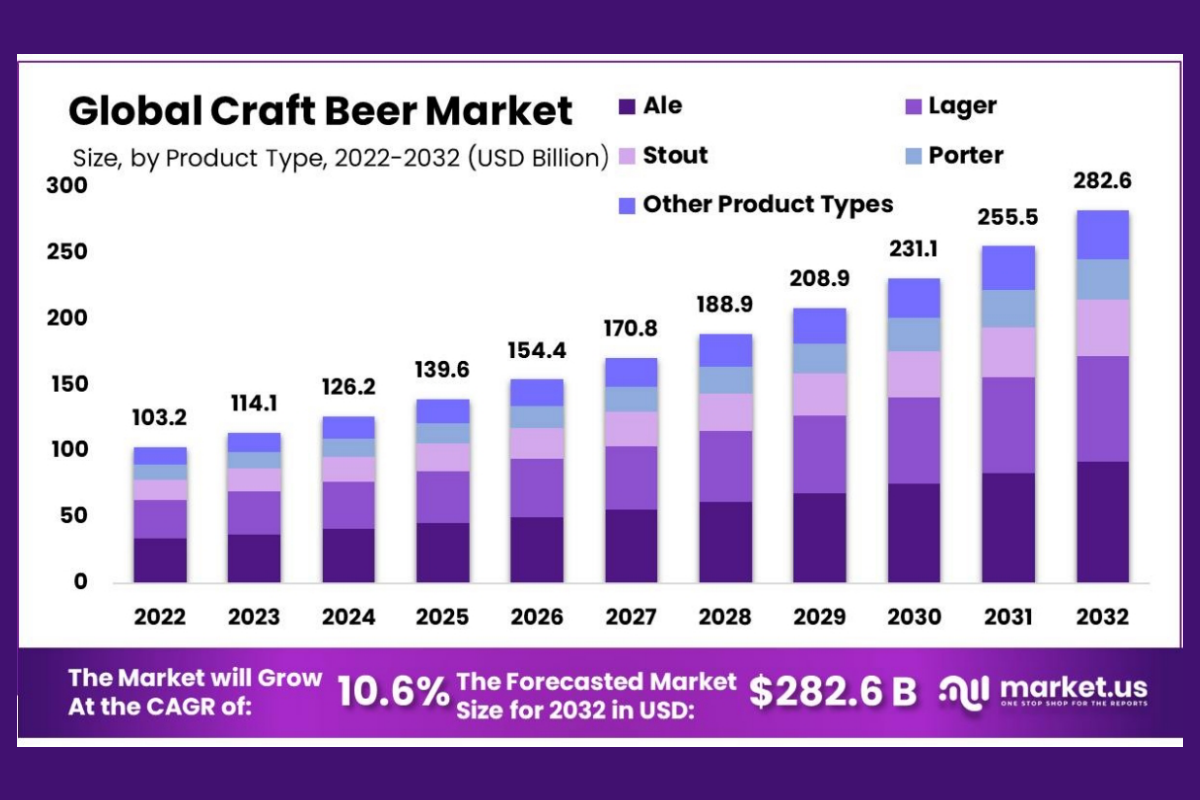
According to a recent estimate, the size of the global craft beer market is anticipated to hit US$282.6 billion by 2032.
According to researchers quoted in a Market.us analysis, the industry, which is presently worth US$103.2 billion, is expected to develop at a compound annual growth rate (CAGR) of 10.6% from 2023 to 2032.U.S.
The ale beer segment “dominated” the craft beer market in 2022, according to drinks experts’ study, in large part because of “its diverse flavour profiles, rich brewing traditions, and ability to cater to a wide range of consumer tastes and preferences.”
The findings show that the off-trade presently has a market share of more than 60% in the craft beer industry and dominates it in terms of distribution.
Analysts described how “the continued establishment of small, independent craft breweries has contributed to market growth. These breweries offer various beer styles, fostering innovation and competition within the industry”. Added to this “craft beer tourism has become a significant driver, with enthusiasts visiting breweries for tours, tastings, and events” a trend which “supports local economies and drives sales for craft breweries”.
The report described “a sophisticated customer base demanding distinctive, regionally brewed tastes has led to an increase in microbreweries in the worldwide craft beer industry. These small-scale brewers are recognized for their high standards, innovation, and individualized products, which put established brands to the test. They provide limited-edition seasonal beers and daring flavour combinations to cater to a variety of palates and skilled workmanship. Customers choose artisan beers with distinctive ingredients like fruits and spices and lower alcohol levels due to health-conscious tendencies.
In terms of geographical analysis, the survey showed how North America, which accounts for 38% of global sales, dominates the market for craft beers worldwide.
It was observed that “pioneering breweries like Sierra Nevada and Anchor Steam helped lay down the roots of craft beer worldwide” as contributing to this supremacy and that “its rich culture, particularly that in both America and Canada.” Additionally, the craft beer industry’s “size and diversity, ranging from small local establishments to large, established players, cater to various consumer preferences” along with “the ‘drink local’ ethos has also driven consumer support for local breweries, ensuring a diverse range of craft beer options” are all factors that contribute to its ability to meet the needs of its customers.
The report also identified and highlighted market restraints for the craft beer market, noting that “various global governments” and problems with “labelling, alcohol content limits, distribution restrictions, and taxation policies” are all difficulties that “regulate” the craft beer market in the end. Analysts noted that “for craft breweries, these regulations can be expensive and time-consuming, preventing market entry and growth.” As a result, “the competitive market presents challenges for new and smaller breweries to maintain profitability,” with small breweries competing for market share and bigger beverage corporations merging. The statement “To succeed, differentiation, branding, and distribution are essential, necessitating innovative strategies to stand out in a crowded market” was made.
The report identified actions that may also help the global craft beer market develop, providing brewers with growth chances to innovate and draw in a larger client base. These explained how “craft beer brands can reach untapped potential in emerging markets through strategic partnerships, exports, and localized marketing.” The analysts added that “this growing market segment can be tapped by promoting sustainability practices and health-conscious brewing” in addition to suggesting that “breweries can invest in eco-friendly production methods, reduce waste, and offer low-alcohol or non-alcoholic craft beer options” in order to appeal to environmentally and health-conscious consumers.
SOURCE: Market.Us
GRAPHIC CREDIT: Market.Us
